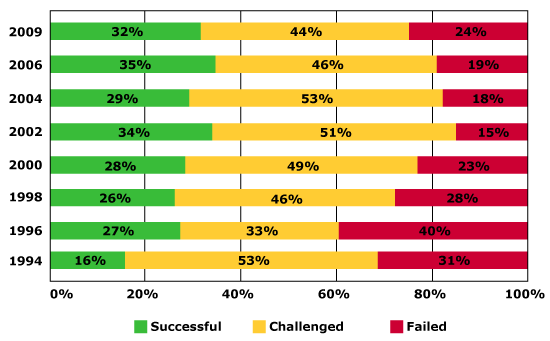Standish Group Chaos Report 2009
Posted By admin On 17/05/18The CHAOS Report 2009 on IT Project Failure By The Standish Group collects information on project failures in the IT industry and environments with the objective of making the industry more successful and to show ways to improve its success rates and increase the value of the IT investments. The latest results have been compiled into the CHAOS Report 2009 published by the organization in April.
The Curious Case of the CHAOS Report 2009. The Standish Group collects information on project failures in the IT industry and environments with the objective of. The Standish Group has released its CHAOS Summary 2009 report. Let the data speak for itself: only 32% of all projects were successful, 44% were challenged, and the.

Problem: it measures success by only looking at whether the projects were completed on time, on budget, and with required features and functions (met user requirements). What happened to the rest of the “six triple constraint”! The organization leaves out of its measures the quality, the risk, and customer satisfaction. Not that we are complaining.

They have the right to measure whatever they want and we have stated before that we have to consider the CHAOS Report results in a recent article on my theory on. But we, PMs, already know that all these measurements work in tandem and need to keep this in mind. Program Clinica Philos Slobozia: Software Free Download there. CHAOS Report – Pie Chart The report shows that software projects now have a 32% success rate compared to 35% from the previous study in 2006 and 16% in 1994. On the other hand, 44% of projects were challenged (late, over budget and/or with less than the required features and functions) while 24% failed (cancelled prior to completion or delivered and never used). Year 2009 Year 2006 Year 2004 Year 2002 Year 2000 Year 1998 Year 1996 Year 1994 Successful 32% 35% 29% 34% 28% 26% 27% 16% Challenged 44% 19% 53% 15% 23% 28% 40% 31% Failed 24% 46% 18% 51% 49% 46% 33% 53% So, must we conclude that project success is a little worse than in 2006 (32% vs.
35%) but definitely better than in 1994 (16%)? Keygen Superior Drummer 2.0 Mac Torrent. For sure, there is better project management expertise (more certified project managers), better training, and better tools and techniques. On the other hand, project complexity and environments have increased while the time to deliver has been reduced. Look at the table above and make your own conclusions. In our opinion, project success in IT has improved when looking at all the many angles that are not being considered by the CHAOS Report. Nevertheless, the figures are still low and need to improve much more. Still, the CHAOS Report continues to be an important measure for the IT industry in spite leaving a lot of curious minds wandering about the methods used.
Jorge Dominguez, PMP®. Great post Jorge! I recently started blogging and incorporated a link to this blog in a recent post of mine. I am thinking about an upcoming post where I would like to discuss executive commitment to project management best practices and its effect on the success of projects.
I have seen many organizations implementing a watered down version of PM or PMO’ssome project templates and a task tracker. Until we have executives viewing PMs as business leaders and not just consultants providing project status, we will continue to see watered down success rates. It honestly is my first time being exposed to project management.Done correctly it’s fruits can be monetarily rewarding for those involved.My novice interpretation is that project management is no different than any other art form,all of it’s components must fall into place an act as one, otherwise the project can turn into a genuine waste of time and money.It is interesting to note how many areas comprise project management,if a project is sucessfull the experience of building it from the ground up can be both a rewarding and exciting experience.